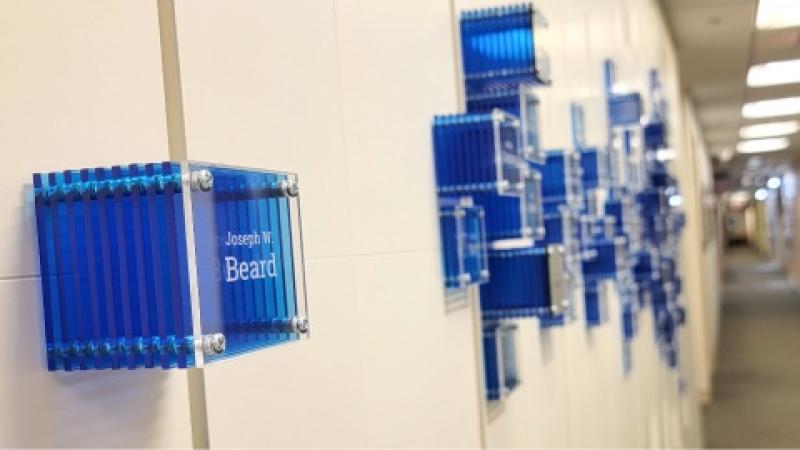
A Century of Discovery: Celebrating Nearly 100 Years of Research in Duke Surgery
Photo above: The “100 Years of Research in Duke Surgery” installation recognizes Duke Surgery's federally funded researchers over a 100-year period. Photo by Scott Behm, Section of Surgical Disciplines.
It’s Valentine’s Day, 1985, and Kent Weinhold, PhD, is in the lab of his mentor Dani Bolognesi, PhD, cycling a series of pharmaceutical compounds through a scintillation counter to measure their effect on retrovirus counts.
“Everything was in duplicate. The no-drug controls were always hundreds of thousands of counts,” Professor of Surgery Dr. Weinhold recalls. “Most of the drugs stayed at hundreds of thousands of counts. And then there was one, there was a duplicate that came up, that had around 30 counts. My first thought was that I screwed up—that I forgot to add something—so I didn’t get all that excited. But then we were able to repeat it.”
The research team had just discovered the world’s first treatment for HIV. By July of 1985, just 5 months later after a rapid clinical trial, the first patients at Duke and at the clinical center of the National Institutes of Health (NIH) were receiving HIV treatment.
For any research facility, this scientific discovery is monumental; for it to happen within a Department of Surgery, is remarkable.
Back to Basics
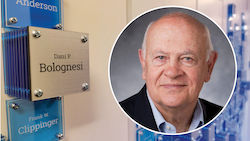
The research infrastructure that existed within Duke’s Department of Surgery in the 1980s was not happenstance—it was the product of a novel approach to surgical training and patient care begun 5 decades earlier by J. Deryl Hart, MD, first chair of the Department of Surgery. From its earliest days, Duke Surgery upheld research as an integral component of its mission.
Dr. Hart had his own lightbulb moment—if you can forgive the pun—with his discovery of ultraviolet light as a successful means of curbing bacterial growth in operating rooms, which could in turn reduce infection rates.
This innovation was proof of concept that scientific discovery conducted by clinicians had the potential to revolutionize surgical care in direct and practical ways.

Distinguished Professor of Experimental Surgery Chief, Division of Surgical Sciences
In 1937, Dr. Hart recruited surgeon Joseph W. Beard, MD, to supervise the Division of Experimental Surgery, a new unit offering a space for collaboration between basic and translational scientists, surgeons, and the rare breed of surgeon–scientists who were skilled in both the laboratory and the operating room.
Dani Bolognesi, PhD, Professor Emeritus of Surgery, was recruited by Dr. Beard in 1971 to continue the department’s research efforts.
He says the early partnership between surgeons and scientists laid an effective groundwork for future scientific discovery, progressed under the leadership of David C. Sabiston, Jr., MD, who joined Duke Surgery as department chair in 1964.
“What Dave [Sabiston] did was not only embrace Beard’s laboratory and research, he took that and said, ‘Now I want to grow a real enterprise around the research that we can do in surgery.' He believed that the surgeon was in a unique position because he had hands on the tissue; he understood the disease. What Dave wanted to do was bring science into that equation and begin to grow what I believe was the beginnings of translational research at Duke.”
- Dr. Dani Bolognesi, Professor Emeritus of Surgery
It Starts with an Idea
Scientific discovery begins with an idea, but to come to fruition, that idea requires proper support and funding. That can be an uphill battle, but today researchers within the Section of Surgical Disciplines have access to a vast infrastructure of administrative support to guide them through the initial processes of refining their aims, identifying budgetary needs, and locating and applying for funding opportunities.
Professor of Surgery and Vice Dean of the Section of Surgical Disciplines Allan D. Kirk, MD, PhD, began the work of expanding research support when he returned to Duke in 2014. As a Duke medical student, surgery resident trained by Dr. Sabiston, and PhD student, Dr. Kirk learned early the competing demands placed upon the surgeon–scientist and the importance of sustaining a strong surgical research program at Duke.
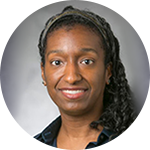
Welcoming researchers through the proverbial doors of the section’s network of research support is Director of Research Development Lauren Anderson, PhD, who provides strategic guidance to investigators in their proposal development.
“There are a lot of good ideas out there,” says Dr. Anderson. “For the surgeons to be able to have enough time to explore those ideas demands having a lot of hands working with them, whether it’s lab personnel or administrative personnel. While it’s harder now than it was before to obtain funding, you still don’t want to totally undo an idea solely to find funding—we want to know what funding opportunities are available, what their ideas are, and match those together.” With more than 20 years of experience in academic research, Dr. Anderson has an intuitive sense of the interests of agencies and sponsors, and a finger on the pulse of constantly changing funding patterns.
Once a potential funding source is identified, the Section of Surgical Disciplines’ Grants and Contracts team comes onboard to take the reins in fine-tuning and to begin the application process in earnest.
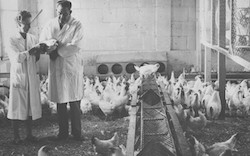
Melissa Murad, Assistant Director of Research Administration, oversees this involved process. Her team does much of the legwork in calculating budgets and connecting to the research cores within the section as needed—biorespository, clinical trials, data management, and others.
“Our team gathers the information provided by the faculty member and does a lot of work behind the scenes to create a proposed draft budget,” says Ms. Murad. “We then work closely with the faculty member to review the intricate details and finalize the budget for submission. We review the RFAs [requests for applications] and make sure everything complies from an administrative standpoint. We want to be a one-stop shop for investigators.”
The support provided by the research administration team allows investigators to focus their effort on their continued research while knowing their developing proposals are in good hands.
Recognizing 100 Years of Scientific Discovery
Receiving funding is a significant milestone in an investigator’s career. For several years, the Section of Surgical Disciplines’ communications team has partnered with research administration to collect historical data for the creation of a unique installation honoring recipients of federal grants, contracts, and sub-awards.
Though federal funding is only one slice of the section’s portfolio, support from the NIH and other federal agencies has been fundamental to the success of Duke Surgery’s research mission.
Starting with Dr. Joseph Beard—who in 1938 received the first federal grant for his research in avian leukemia viruses—the display features an engraved tile for each investigator in the Section of Surgical Disciplines earning federal funding. For each subsequent federal award, the investigator receives another tile to their stack, capping out at 10 awards.
The display is presented as a timeline and will continue to expand until 2038, signifying the end of one century of research in the Section of Surgical Disciplines. Lauren Halligan, CMI, a medical illustrator with a creative and architectural eye, developed the design and oversaw the production and installation of the display.

Medical Illustrator
“I think one of the most challenging features of the installation, but what will end up being one of its coolest, was Dr. Kirk’s desire to keep it dynamic and to update it every few years as new faculty join the research mission or else further expand their research portfolios,” Ms. Halligan says. “What it looks like this year—its colors, depths, and stack distribution—will be different from how it looks in another five or ten years.”
The dynamic installation is a striking visual representation of the breadth, depth, and scale of research conducted within Duke Surgery. The literal building blocks echo the foundational nature of discovery, in which one investigator’s work builds upon all that came before them.
See the Problem, Fix the Problem
In many ways, the Section of Surgical Disciplines owes the continued growth of its research enterprise to the unique, symbiotic relationship between surgeons and scientists, which continues to fuel scientific discovery and aims to better understand the intricacies of disease as a means of combating it.
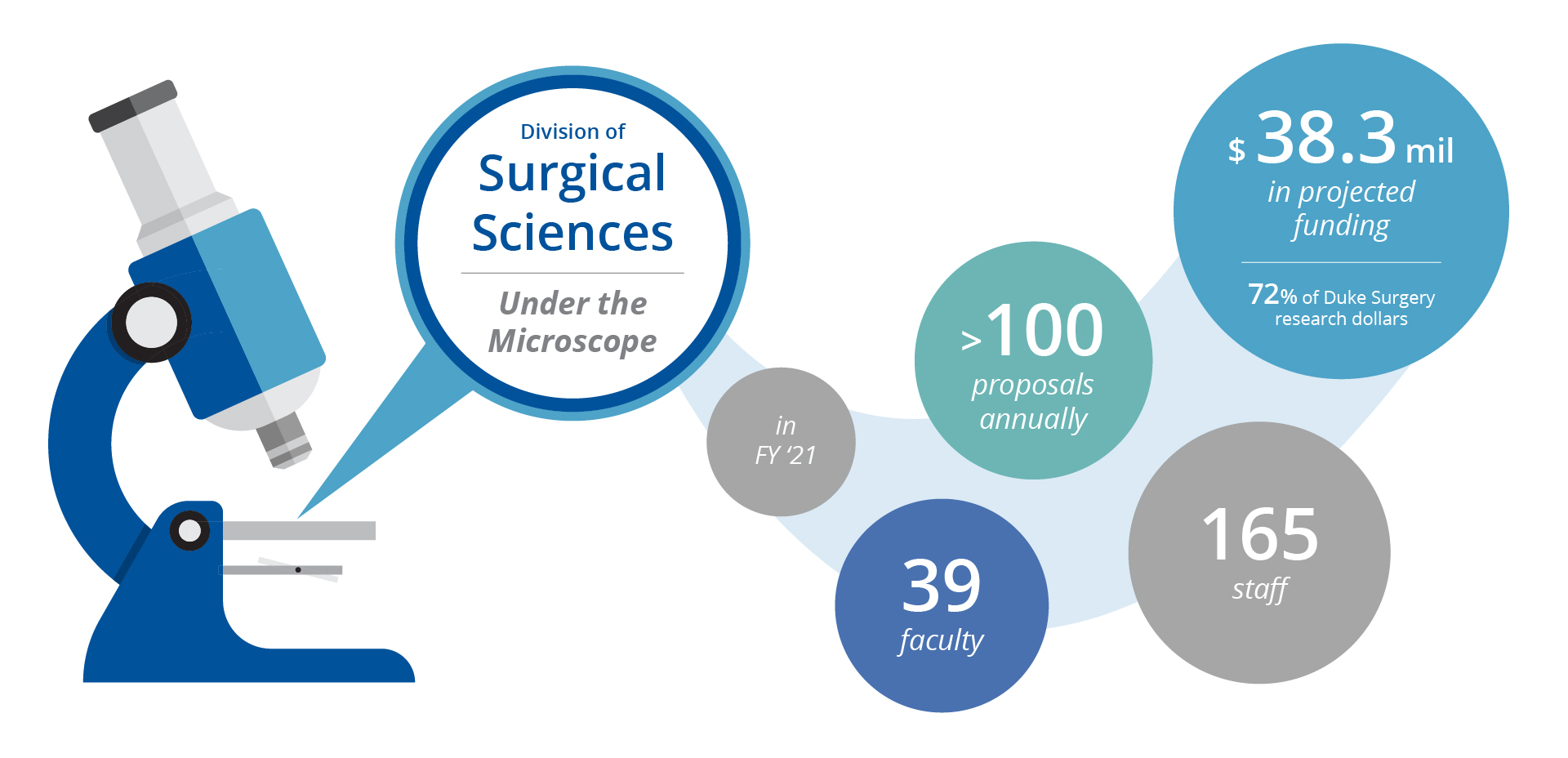
Even though this partnership between MDs and PhDs will sometimes turn heads, Dr. Kent Weinhold says it has been beneficial for all parties involved. He now serves as division chief of the Division of Surgical Sciences, a division focused on scientific research with more faculty members than some departments at Duke.
“I was just asked yesterday why as a basic scientist I would want to be in surgery. While it’s extraordinarily important to have access to tissue banking, the real driving force for me is that I want to make a contribution; I want to make a difference. Physicians make a difference every day, but as basic scientists in the lab we do esoteric things that hopefully will translate eventually. This [partnership] really creates opportunity for us to impact the standard of care, and also to take advantage of the surgical mentality of ‘see the problem, fix the problem.’”
- Dr. Kent Weinhold, Chief, Division of Surgical Sciences
One doesn’t need to look far to witness a profound and timely example of this potential for impact. The development of mRNA vaccines was first researched within Duke Surgery in the 1990s by Smita Nair, PhD, Professor in Surgery, paving the way for the development of the COVID-19 vaccine in 2020.
Research conducted by investigators today has untapped potential to solve unknown problems tomorrow. After nearly 100 years of testing, that hypothesis is proven correct.
To view the “100 Years of Research in Duke Surgery” installation, visit Duke Surgery’s 7th floor administrative suite within the Hospital Addition for Surgery Building (HAFS) on the Duke University Hospital campus.
Give to Duke Surgery
A gift to the Department of Surgery is a gift of knowledge, discovery, and life.